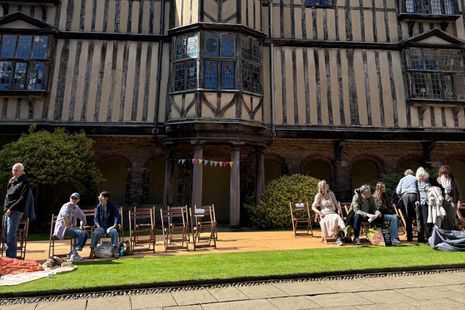Much Ado About Nothing: merriment in May Week
Director Imogen Carter strikes a wonderful balance between ‘rom’ and ‘com’ in this cheerful production of the Shakespearean classic

The sun is shining and an excited crowd packs into Queens’ College’s enchanting Cloister Court; a charming, summery play is evidently about to begin. The medieval architectural backdrop of this play under the blue skies (finally!) of May Week is the perfect way to enjoy this merry Shakespearean rom-com (I definitely recommend sunglasses and sun cream though). The panoramic Tudor court immerses the audience in the romantic world of Much Ado About Nothing, where the cast moves among the spectators and takes full advantage of the cloisters and bushes to generate an engaging and immersive experience.
The Midsummer Night’s Dream-esque quality of the costumes (flowing floral dresses, loose waistcoats, and flower crowns) plunges the audience further into this romanticised Shakespearean environment of joviality and playfulness. The fairytale aesthetic is enhanced by the bunting and flower garlands which deck the Cloister Court while, during the interval, actors garb members of the audience with colourful flower crowns.
“This production was a delightful addition to my May Week itinerary”
The excellent staging throughout the play exhibits Imogen Carter’s directorial talents. Her choreographic skills are established in the opening scene when four women create a dynamic display of exposition before they are cloistered to one end of the stage by an intrusion of male characters – thus, each set of actors are bundled together in a striking gender-sequestered image. Carter use this unique traverse stage to her advantage throughout the drama, with particular success during the wedding scene. She often utilises the large cast to her advantage, such as when every character stands up abruptly from their positions among the audience in outrage at Claudio’s cruel rejection of Hero. The coordination of the cast onstage is often representative of unity or isolation between the characters. For example, the group surrounding Hero when she faints after being slandered at the wedding signals cohesion and harmony. She is then left alone on stage, symbolising her vulnerability.
The excellent ensemble embody their characters both when speaking and when out of focus, unfailingly remaining in character to amplify the comedic mood and vividness of the setting. Performances which elicited lots of laughter from the audience include Romola Goldfarb’s mischievous delivery as Margaret and Connor Nainthy’s slapstick performance as Borachio. Don Pedro (Joe Orrell) also delighted audience members during his whispered asides, successfully immersing the audience further into the setting. Ludicrous humour is a constant in this play thanks to the comedic relief provided by the foolish watch (Annie Fogden as Dogberry and Jack Marley as Verges) and the ironically villainous Don Jon (Emily Megoran).
“The excellent staging of the actors throughout the play exhibits Imogen Carter’s directorial talents”
Joe Wright’s performance as Benedick is an exceptional embodiment of character, wherein his voice and gestures subtly reveal his shift of attitude from a scorner of lovers into a hopeless lover himself. As Beatrice, Lucy Miller displays a similar nuanced understanding of character as she shifts from an exaggeratedly disgusted response to Don Pedro’s proposal into defensive embarrassment when accused of loving Benedick. The stuttering, nervous interactions between Hero (Emma Dawes) and Claudio (Rob Monteiro) highlight their infatuated puppy love, contrasting the familiarity of the chemistry between Benedick and Beatrice.
However, there was just too much Much Ado. By the end of the much longer first half, the sun beating down on me was becoming unpleasant and my attention span was dwindling. I was grateful for the interval to stand up and grab some ice cream. Elsewhere, the play struggled with finding a secure place for music. While the whimsical live guitar and saxophone ought to lend a fanciful note to the play, the infrequency and brevity of these accompaniments revealed hints of uncertainty about their inclusion.
But, I thoroughly enjoyed Carter’s captivating production of Much Ado as a convincing rom-com, thanks to the chemistry – both platonic and romantic – between the cast, as well as exceptional comedic delivery. This production was a delightful addition to my May Week itinerary. The fantastic dance routine (at the masquerade ball, and then refrained at the second wedding) put me in the right mood for the Jesus May Ball the following day.
Much Ado About Nothing showed at the Queens’ College Cloister Court from Saturday 15th until Monday 17th June, at 2pm.
 Comment / Cambridge’s tourism risks commodifying students18 April 2025
Comment / Cambridge’s tourism risks commodifying students18 April 2025 News / Varsity ChatGPT survey17 April 2025
News / Varsity ChatGPT survey17 April 2025 News / Cambridge researchers build tool to predict cancer treatment success19 April 2025
News / Cambridge researchers build tool to predict cancer treatment success19 April 2025 News / Cambridge researchers find ‘strongest evidence yet’ of life on distant exoplanet18 April 2025
News / Cambridge researchers find ‘strongest evidence yet’ of life on distant exoplanet18 April 2025 News / Greenwich House occupiers miss deadline to respond to University legal action15 April 2025
News / Greenwich House occupiers miss deadline to respond to University legal action15 April 2025






